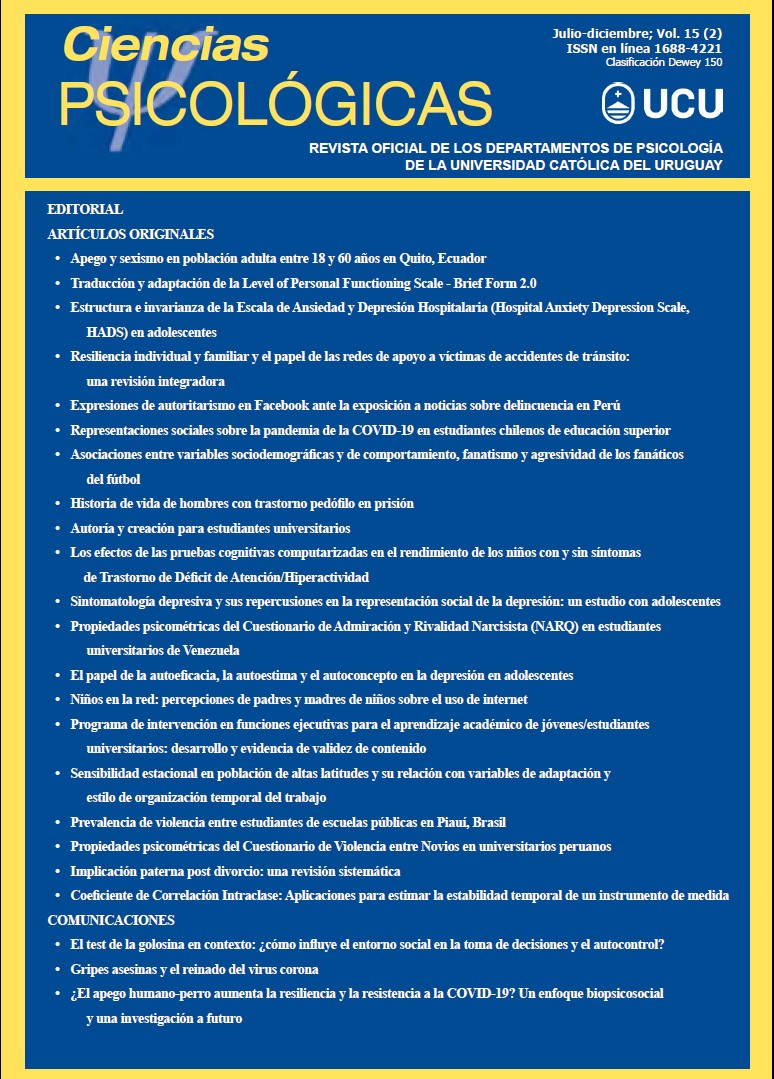Associations between sociodemographic and behavioural variables, fanaticism and aggressiveness of soccer fans
DOI:
https://doi.org/10.22235/cp.v15i2.2390Keywords:
aggressiveness, violence, fanaticism, soccer fans, organized fansAbstract
Soccer fans’ aggressiveness has serious consequences for individuals and society. However, its predictive factors have been poorly investigated. This study aimed to examine variables that predict soccer fans’ aggressiveness. This survey, correlational and cross-sectional research involved 210 participants, which were equivalent in crowd type (105 belonging to organized fan crowds and 105 not belonging to organized fan crowds), sex and age. The measurement instruments were: sociodemographic, occupational and behavioural questionnaires; the Fanaticism Scale for Football Fans; and the Buss and Perry Aggression Questionnaire. Results showed high aggressiveness in both groups and correlations between aggressiveness and fanaticism, sociodemographic and behavioural variables. Furthermore, the predictors of aggressiveness were fanaticism, age and time affiliated with the organized crowd. Therefore, it is concluded that sociodemographic and behavioural variables and fanaticism are important for understanding this phenomenon.
Downloads
References
Allen, J. J., & Anderson, C. A. (2017). General aggression model. The international encyclopedia of media effects, 1-15. doi: https://doi.org/10.1002/9781118783764.wbieme0078
Brandão, T., Murad, M., Belmont, R., & Santos, R. F. (2020). Álcool e violência: Torcidas organizadas de futebol no Brasil. Movimento (ESEFID/UFRGS), 26, 1-14. doi: https://doi.org/10.22456/1982-8918.90431
Britto, F. R., & Mattoso, C. Q. (2018). Consumo sagrado ou sagrado consumo? As implicações dessa sacralização na hierarquia de valores. Pensamento & Realidade, 33(2), 48-64.
Buss, A. H., & Perry, M. (1992). The aggression questionnaire. Journal of Personality and Social Psychology, 63(3), 452-459. doi: http://doi.org/10.1037/0022-3514.63.3.452
Carriedo, A., Cecchini, J. A., & González, C. (2020). Soccer spectators’ moral functioning and aggressive tendencies in life and when watching soccer matches. Ethics & Behavior, 1-15. doi: https://doi.org/10.1080/10508422.2020.1715801
Cordeiro, L. B., & Silva, S. R. (2017). Sobre Torcedores Organizados Brasileiros em Contextos Migrantes: Um Estudo Exploratório. Revista do Programa de Pós-graduação Interdisciplinar em Estudos do Lazer, 20(2), 99-138.
Dimmock, J. A., & Grove, J. R. (2005). Relationship of fan identification to determinants of aggression. Journal of Applied Sport Psychology, 17(1), 37-47. doi: https://doi.org/10.1080/10413200590907559
Dwyer, B., LeCrom, C., & Greenhalgh, G. P. (2016). Exploring and measuring spectator sport fanaticism. Communication and Sport, 6(1), 58-85. doi: https://doi.org/10.1177/2167479516679411
Field, A. (2009). Descobrindo a estatística usando o SPSS-2 (2° ed.). Porto Alegre: ArtMed Editora.
Gonçalves, A. D. A. A., & Dutra, R. C. (2018). A preservação da ordem pública nos estádios de futebol por meio do cadastramento biométrico das torcidas organizadas no estado de Santa Catarina. Revista Ordem Pública, 10(1), 95-114.
Gouveia, V. V., Chaves, C. M. C. M., Peregrino, R. R., Branco, A. O. C., & Gonçalves, M. P. (2008). Medindo a agressão: o Questionário de Buss-Perry. Arquivos Brasileiros de Psicologia, 60(3), 92-103.
Hilliard, R. C., & Johnson, C. G. (2018). Sport Fan Attitudes and Willingness to Commit Aggressive Acts. Journal of Sport Behavior, 41(3), 305-329.
Hollanda, B. B. B., & Medeiros, J. (2016). Violência, juventude e idolatria clubística: Uma pesquisa quantitativa com torcidas organizadas de futebol no Rio de Janeiro e em São Paulo. Revista Hydra: Revista Discente de História da UNIFESP, 1(2), 97-125. doi: https://doi.org/10.34024/hydra.2016.v1.9135
Knapton, H., Espinosa, L., Meier, H. E., Bäck, E. A., & Bäck, H. (2018). Belonging for violence: Personality, football fandom, and spectator aggression. Nordic Psychology, 70(4), 278-289. doi: https://doi.org/10.1080/19012276.2018.1430611
Lopes, F. T. P., & Hollanda, B. B. B. D. (2018). “Ódio eterno ao futebol moderno”: poder, dominação e resistência nas arquibancadas dos estádios da cidade de São Paulo. Tempo, 24(2), 206-232. doi: https://doi.org/10.1590/tem-1980-542x2018v240202
Marchiori, M., & Vecchi, M. (2020). Secrets of soccer: Neural network flows and game performance. Computers & Electrical Engineering, 81, 106505. doi: https://doi.org/10.1016/j.compeleceng.2019.106505
Murad, M. (2017). A violência no futebol: novas pesquisas, novas ideias novas propostas (2ª ed.). São Paulo: Benvirá.
Neuman, W. L. (2014). Social research methods: Qualitative and quantitative approaches (7th ed.). Pearson education.
Reis, H. H. B., Martins, M. Z., Spaaij, R., & Lopes, F. T. P. (2018). Drinking dangerously? Revista Brasileira de Educação Física e Esporte, 32(2), 277-288. doi: https://doi.org/10.11606/1807-5509201800020277
Rice, M. E., & Harris, G. T. (2005). Comparing effect sizes in follow-up studies: ROC Area, Cohen's d, and r. Law and human behavior, 29(5), 615-620. doi: https://doi.org/10.1007/s10979-005-6832-7
Shoham, A., Dalakas, V., & Lahav, L. (2015). Consumer misbehavior: Aggressive behavior by sports fans. Services Marketing Quarterly, 36(1), 22-36. doi: https://doi.org/10.1080/15332969.2015.976506
Silva, W. R., Freitas, K. T. D., Carvalho, H. P., Medeiros, T., & Cardoso, F. L. (2017). Torcedores de clubes de Futebol da cidade de Florianópolis: perfil sociodemográfico e comportamental. Revista Brasileira de Futsal e Futebol, 9(33), 197-205.
Souza, E. A. P. (2020). As gerações de grupos organizados de torcedores no Brasil. Revista Eletrônica de Ciências Sociais, (31), 192-218. doi: https://doi.org/10.34019/1981-2140.2020.30164
Toder-Alon, A., Icekson, T., & Shuv-Ami, A. (2018). Team identification and sports fandom as predictors of fan aggression: The moderating role of ageing. Sport Management Review, 22(2), 194-208. doi: https://doi.org/10.1016/j.smr.2018.02.002
Turğut, M., Yaşar, O. M., Sunay, H., Özgen, C., & Beşler, H. K. (2018). Evaluating aggression levels of sport spectators. European Journal of Physical Education and Sport Science, 4, 1-12. doi: https://doi.org/10.5281/zenodo.1196665
Van der Meij, L., Klauke, F., Moore, H. L., Ludwig, Y. S., Almela, M., & Van Lange, P. A. M. (2015). Football Fan aggression: the importance of low basal cortisol and a fair referee. PloS One, 10(4). doi: https://doi.org/10.1371/journal.pone.0120103
Wachelke, J. F., Andrade, A. L. D., Tavares, L., & Neves, J. R. (2008). Mensuração da identificação com times de futebol: evidências de validade fatorial e consistência interna de duas escalas. Arquivos Brasileiros de Psicologia, 60(1), 96-111.
Wann, D. L., Lane, T. M., Duncan, L. E., & Goodson, S. L. (1998). Family status, preference for sport aggressiveness, and sport fan motivation. Perceptual and motor skills, 86(3 suppl.), 1419-1422. doi: https://doi.org/10.2466/pms.1998.86.3c.1419
Winands, M., Grau, A., & Zick, A. (2017). Sources of identity and community among highly identified football fans in Germany. An empirical categorisation of differentiation processes. Soccer & Society, 20(2), 216-231. doi: https://doi.org/10.1080/14660970.2017.1302934
Downloads
Published
How to Cite
Issue
Section
License
Copyright (c) 2021 Universidad Católica del Uruguay

This work is licensed under a Creative Commons Attribution 4.0 International License.
















